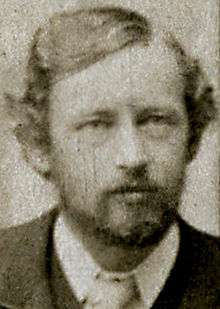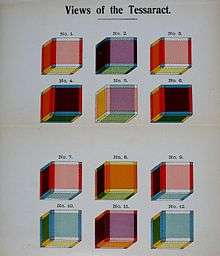Charles Howard Hinton

Charles Howard Hinton (1853, United Kingdom – 30 April 1907, Washington D.C., United States) was a British mathematician and writer of science fiction works titled Scientific Romances. He was interested in higher dimensions, particularly the fourth dimension. He is known for coining the word "tesseract" and for his work on methods of visualising the geometry of higher dimensions.
Life
Hinton taught at Cheltenham College[1] while he studied at Balliol College, Oxford, where he obtained his B.A. in 1877. From 1880 to 1886, he taught at Uppingham School in Rutland, where Howard Candler, a friend of Edwin Abbott Abbott's, also taught.[2] Hinton also received his M.A. from Oxford in 1886.
In 1880 Hinton married Mary Ellen, daughter of Mary Everest Boole and George Boole, the founder of mathematical logic.[3] The couple had four children: George (1882–1943), Eric (*1884), William (1886–1909)[4] and Sebastian (1887–1923) inventor of the Jungle gym. In 1883 he went through a marriage ceremony with Maud Florence, by whom he had had twin children, under the assumed identity of John Weldon. He was subsequently convicted of bigamy and spent three days in prison, losing his job at Uppingham.[5] His father James Hinton was a radical advocate of polygamous relationships,[6] and according to Charles' mother James had once remarked to her: "Christ was the saviour of Men but I am the saviour of Women and I don't envy him a bit."[7] In 1887 Charles moved with Mary Ellen to Japan to work in a mission before accepting a job as headmaster of the Victoria Public School. In 1893 he sailed to the United States on the SS Tacoma to take up a post at Princeton University as an instructor in mathematics.[5]
In 1897, he designed a gunpowder-powered baseball pitching machine for the Princeton baseball team's batting practice.[5][8] The machine was versatile, capable of variable speeds with an adjustable breech size, and firing curve balls by the use of two rubber-coated steel fingers at the muzzle of the pitcher.[9] He successfully introduced the machine to the University of Minnesota, where Hinton worked as an assistant professor until 1900, when he resigned to move to the U.S. Naval Observatory in Washington, D.C.[5]
At the end of his life, Hinton worked as an examiner of chemical patents for the United States Patent Office. At age 54, he died unexpectedly of a cerebral hemorrhage on 30 April 1907.[10][11] After Hinton's sudden death his wife, Mary Ellen, committed suicide in Washington, D.C. in May 1908.[12]
Fourth dimension

In an 1880 article entitled "What is the Fourth Dimension?", Hinton suggested that points moving around in three dimensions might be imagined as successive cross-sections of a static four-dimensional arrangement of lines passing through a three-dimensional plane, an idea that anticipated the notion of world lines. Hinton's explorations of higher space had a moral basis:
- Hinton argues that gaining an intuitive perception of higher space required that we rid ourselves of the ideas of right and left, up and down, that inheres in our position as observers in a three-dimensional world. Hinton calls the process "casting out the self", equates it with the process of sympathizing with another person, and implies the two processes are mutually reinforcing.[13]
Hinton created several new words to describe elements in the fourth dimension. According to OED, he first used the word tesseract in 1888 in his book A New Era of Thought. He also invented the words kata (from the Greek for "down from") and ana (from the Greek for "up toward") to describe the additional two opposing fourth-dimensional directions (an additional 4th axis of motion analogous to left-right (x), up-down (y), and forwards-backwards (z)).[14]
Hinton's Scientific romances, including "What is the Fourth Dimension?" and "A Plane World", were published as a series of nine pamphlets by Swan Sonnenschein & Co. during 1884–1886. In the introduction to "A Plane World", Hinton referred to Abbott's recent Flatland as having similar design but different intent. Abbott used the stories as "a setting wherein to place his satire and his lessons. But we wish in the first place to know the physical facts." Hinton's world existed along the perimeter of a circle rather than on an infinite flat plane.[15] He extended the connection to Abbott's work with An Episode on Flatland: Or How a Plain Folk Discovered the Third Dimension (1907).
Influence
Hinton was one of the many thinkers who circulated in Jorge Luis Borges's pantheon of writers. Hinton is mentioned in Borges' short stories "Tlön, Uqbar, Orbis Tertius", "There Are More Things" and "El milagro secreto" ("The Secret Miracle"):
| “ | He judged A Vindication of Eternity to be less unsatisfactory, perhaps. The first volume documents the diverse eternities that mankind has invented, from Parmenides' static Being to Hinton's modifiable past; the second denies (with Francis Bradley) that all the events of the universe constitute a temporal series.[16] | ” |
Hinton influenced P. D. Ouspensky's thinking. Many of ideas Ouspensky presents in "Tertium Organum" mention Hinton's works.
Hinton's "scientific romance," the "Unlearner" is cited by John Dewey in "Art as Experience", chapter 3.
Hinton is the main character of Carlos Atanes's play Un genio olvidado (Un rato en la vida de Charles Howard Hinton). The play was premiered on Madrid in May 2015.
Hinton is mentioned several times in Alan Moore's graphic novel From Hell; his theories regarding the fourth dimension form the basis of the book's final chapter. His father, James Hinton, appears in chapters 4 and 10.
He is mentioned twice in Aleister Crowley's novel Moonchild. The first mention mistakenly names his father, James Hinton.
Works
- Hinton, Charles Howard; Webb, James, introduction (1976) [1884]. Scientific Romances: First and Second Series, (PDF). Arno Press. ISBN 0-405-07954-0. Retrieved 22 May 2013. and 2nd series at Internet Archive
- A New Era of Thought, orig. 1888, reprinted 1900, by Swan Sonnenschein & Co. Ltd., London
- The Fourth Dimension, orig. 1904, 1912 by Ayer Co., Kessinger Press reprint, ISBN 0-405-07953-2, scanned version available online at the Internet Archive
- Speculations on the Fourth Dimension: Selected Writings of Charles H. Hinton, edited by Rudolf Rucker, 1980, Dover Publications, ISBN 0-486-23916-0 (includes selections from Scientific Romances, The Fourth Dimension, "The Recognition of the Fourth Dimension" from the 1902 Bulletin of the Philosophical Society of Washington, and excerpts from An Episode of Flatland)
- An Episode of Flatland or How a Plane Folk Discovered the Third Dimension orig 1907, Swan Sonnenschein & Co. Limd., uncut illustrated HTML version online at Forgotten Futures
- What is the Fourth Dimension? (1880)
See also
Notes
- ↑ Cheltenham College Register, 1841-1889. London: Bell. 1890.
- ↑ British Society for the History of Mathematics Gazeteer.
- ↑ Batchelor, George (1994). The Life and Legacy of G. I. Taylor. Cambridge University Press. p. 7. ISBN 0-521-46121-9.
- ↑ Smothers In Orchard in The Los Angeles Times v. 27 February 1909.
- 1 2 3 4 Bernard V. Lightman (1997). Victorian science in context. University of Chicago Press. p. 266. ISBN 0-226-48111-5.
- ↑ A cultural history of higher space, 1853-1907 [work in progress Mark Blacklock
- ↑ Havelock Ellis papers, British Library.
- ↑ Hinton, Charles, "A Mechanical Pitcher", Harper's Weekly, 20 March 1897, p. 301–302.
- ↑ Hinton, Charles, "The Motion of a Baseball", The Yearbook of the Minneapolis Society of Engineers, May, 1908, p. 18–28.
- ↑ "Scientist Drops Dead", Washington Post, 1 May 1907.
- ↑ Several of these references are cited in the introduction to the book Speculations on the Fourth Dimension, edited by Rudolf Rucker.
- ↑ `My Right To Die´, Woman Kills Self in The Washington Times v. 28 May 1908 (PDF); Mrs. Mary Hinton A Suicide in The New York Times v. 29 May 1908 (PDF).
- ↑ Anne De Witt (2013) Moral Authority, Men of Science, and the Victorian Novel, page 173, Cambridge University Press ISBN 1107036178
- ↑ Rucker, Rudy. "Spaceland Notes" (PDF).
- ↑ Hinton, Charles H. "A Plane World". Dover Publications. Retrieved 2 April 2011.
- ↑ Borges, Jorge Luis. The Secret Miracle. In: Fictions. Penguin Books, 2000, p. 126
Further reading
- Crabb, Jon (October 28, 2015). "Notes on the Fourth Dimension". The Public Domain Review. 5 (20).
 Illustrated cultural history, with links to primary sources and secondary literature.
Illustrated cultural history, with links to primary sources and secondary literature.
External links
| Wikisource has original works written by or about: Charles Howard Hinton |
| Wikimedia Commons has media related to Charles Howard Hinton. |
- Hinton's writings at ibiblio.org
- Works by or about Charles Howard Hinton at Internet Archive
- Works by or about Charles Howard Hinton in libraries (WorldCat catalog)